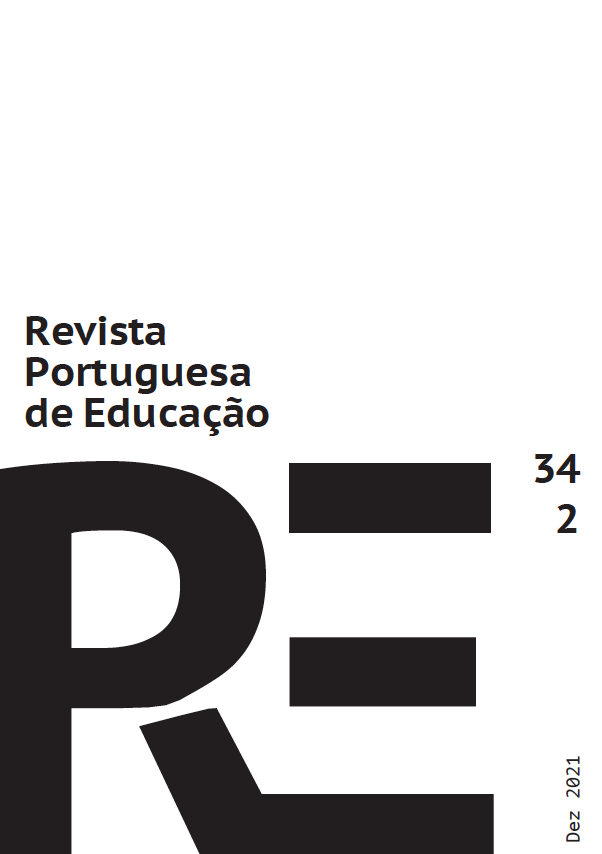Desempenho escolar e diferentes papéis de participação no bullying: Um estudo transcultural
DOI:
https://doi.org/10.21814/rpe.17330Palavras-chave:
Violência Escolar, Bullying, Desempenho EscolarResumo
O objetivo deste estudo é comparar o desempenho escolar entre os diferentes papéis de participação no bullying em dois países (Brasil e Portugal). Consiste num estudo transcultural de corte transversal de cunho exploratório e amostragem intencional. 376 crianças e adolescentes (do 5º e 6º ano de escolas públicas e privadas) participaram deste estudo, sendo 197 de Portugal e 179 do Brasil. Os papéis de participação no bullying foram obtidos mediante a aplicação de uma escala sociométrica e o desempenho escolar foi avaliado pelas médias finais obtidas ao final do ano letivo de quatro disciplinas (ciências, inglês, matemática e português). Os dados foram analisados através da estatística descritiva e inferencial (teste Kruskal-Wallis e U de Mann-Whitney). Destaca-se que em Portugal as vítimas apresentaram melhor desempenho escolar. Já no Brasil não foram encontradas diferenças significativas. Os dados apontam que o desempenho escolar parece ser uma variável mais importante no estabelecimento dos papéis de participação no bullying em Portugal do que no Brasil, indicando que a relação entre essas variáveis não pode ser considerada característica padrão entre os envolvidos neste fenómeno em diferentes países.
Downloads
Referências
Al-Bitar, Z. B., Al-Omari, I. K., Sonbol, H. N., Al-Ahmad, H. T. & Cunningham, S. J. (2013). Bullying among Jordanian schoolchildren, its effects on school performance, and the contribution of general physical and dentofacial features. Am J Orthod Dentofacial Orthop, 144(6), 872-878. http://doi.org/10.1016/j.ajodo.2013.08.016
Albdour, M. & Krouse, H. J. (2014). Bullying and victimization among African American adolescents: a literature review. J Child Adolesc Psychiatr Nurs, 27(2), 68-82. http://doi.org/10.1111/jcap.12066
Anthony, B. J., Wessler, S. L. & Sebian, J. K. (2010). Commentary: guiding a public health approach to bullying. J Pediatr Psychol, 35(10), 1113-1115. http://doi.org/10.1093/jpepsy/jsq083
Barboza, G. E. (2015). The association between school exclusion, delinquency and subtypes of cyber- and F2F-victimizations: identifying and predicting risk profiles and subtypes using latent class analysis. Child Abuse Negl, 39, 109-122. http://doi.org/10.1016/j.chiabu.2014.08.007
Barboza, G. E., Schiamberg, L. B., Oehmke, J., Korzeniewski, S. J., Post, L. A. & Heraux, C. G. (2009). Individual characteristics and the multiple contexts of adolescent bullying: an ecological perspective. J Youth Adolesc, 38(1), 101-121. http://doi.org/10.1007/s10964-008-9271-1
Bilić, V., Flander, G. B. & Rafajac, B. (2014). Life satisfaction and school performance of children exposed to classic and cyber peer bullying. Coll Antropol, 38(1), 21-29.
Bowes, L., Maughan, B., Ball, H., Shakoor, S., Ouellet-Morin, I., Caspi, A., . . . Arseneault, L. (2013). Chronic bullying victimization across school transitions: the role of genetic and environmental influences. Dev Psychopathol, 25(2), 333-346. http://doi.org/10.1017/S0954579412001095
Busch, V., Laninga-Wijnen, L., Schrijvers, A. J. & De Leeuw, J. R. (2015). Associations of health behaviors, school performance and psychosocial problems in adolescents in The Netherlands. Health Promot Int., 32(2), 280-291. http://doi.org/10.1093/heapro/dav058
Cardoos, S. L. & Hinshaw, S. P. (2011). Friendship as protection from peer victimization for girls with and without ADHD. J Abnorm Child Psychol, 39(7), 1035-1045. http://doi.org/10.1007/s10802-011-9517-3
Chang, F. C., Lee, C. M., Chiu, C. H., Hsi, W. Y., Huang, T. F., & Pan, Y. C. (2013). Relationships among cyberbullying, school bullying, and mental health in Taiwanese adolescents. J Sch Health, 83(6), 454-462. http://doi.org/10.1111/josh.12050
Coie, J. D., Dodge, K. A. & Coppotelli, H. (1982). Dimensions and types of social status: A cross-age perspective. Developmental Psychology, 18, 557–570.
Copeland, W. E., Wolke, D., Angold, A. & Costello, E. J. (2013). Adult psychiatric outcomes of bullying and being bullied by peers in childhood and adolescence. JAMA Psychiatry, 70(4), 419-426. http://doi.org/10.1001/jamapsychiatry.2013.504
Cornell, D. & Mehta, S. B. (2011). Counselor confirmation of middle school student self-reports of bullying victimization. Professional School Counseling, 14(4), 261–270.
Costa, P. & Pereira, B. (2010). O bullying na escola: a prevalência e o sucesso escolar. Paper presented at the I Seminário Internacional “Contributos da Psicologia em Contextos Educativos”, Braga.
Craig, W., Harel-Fisch, Y., Fogel-Grinvald, H., Dostaler, S., Hetland, J., Simons-Morton, B., Molcho, M., Mato, M. G., Overpeck, M., Due, P. & Pickett, W. (2009). A cross-national profile of bullying and victimization among adolescents in 40 countries. International Journal of Public Health, 54(2), 216-224.
Dalosto, M. M. & Alencar, E. M. L. S. (2013). Manifestações e prevalência de bullyng entre alunos com altas habilidades/superdotação. Revista Brasileira de Educação Especial, 19, 363-378.
Elias, L. (2003). Crianças que apresentam baixo rendimento escolar e problemas de comportamento associados: caracterização e intervenção [Doctoral dissertation, Universidade de São Paulo, Brasil]. https://repositorio.usp.br/item/001334977
Espelage, D. L. & de la Rue, L. (2013). School bullying: its nature and ecology. In J. C. Srabstein & J. Merrick (Eds.), Bullying: A Public Health Concern (pp. 23-38). Nova Science Publishers
Freire, I., Simão, A. & Ferreira, A. (2006). O estudo da violência entre pares no 3º ciclo do ensino básico: um questionário aferido para a população escolar portuguesa. Revista Portuguesa de Educação, 19(2), 157-183.
Galvão, D. P. (2009). Os nerds ganham poder e invadem a TV. Revista Intraciência, 001, 34-41.
Glew, G. M., Fan, M. Y., Katon, W. & Rivara, F. P. (2008). Bullying and school safety. J Pediatr, 152(1), 123-128, 128.e121. http://doi.org/10.1016/j.jpeds.2007.05.045
Gower, A. L., McMorris, B. J., & Eisenberg, M. E. (2015). School-level contextual predictors of bullying and harassment experiences among adolescents. Soc Sci Med, 147, 47-53. http://doi.org/10.1016/j.socscimed.2015.10.036
Harel-Fisch, Y., Walsh, S. D., Fogel-Grinvald, H., Amitai, G., Pickett, W., Molcho, M., . . . Group, M. o. t. H. V. a. I. P. F. (2011). Negative school perceptions and involvement in school bullying: a universal relationship across 40 countries. J Adolesc, 34(4), 639-652. http://doi.org/10.1016/j.adolescence.2010.09.008
Huepe, D., Roca, M., Salas, N., Canales-Johnson, A., Rivera-Rei, Á., Zamorano, L., . . . Ibañez, A. (2011). Fluid intelligence and psychosocial outcome: from logical problem solving to social adaptation. PLoS One, 6(9), e24858. http://doi.org/10.1371/journal.pone.0024858
Khamis, V. (2015). Bullying among school-age children in the greater Beirut area: risk and protective factors. Child Abuse Negl, 39, 137-146. http://doi.org/10.1016/j.chiabu.2014.08.005
Krukowski, R. A., West, D. S., Philyaw Perez, A., Bursac, Z., Phillips, M. M. & Raczynski, J. M. (2009). Overweight children, weight-based teasing and academic performance. Int J Pediatr Obes, 4(4), 274-280. http://doi.org/10.3109/17477160902846203
Kubwalo, H., Muula, A. S., Siziya, S., Pasupulati, S. & Rudatsikira, E. (2013). Prevalence and correlates of being bullied among in-school adolescents in Malawi: results from the 2009 Global School-Based Health Survey. Malawi Med J, 25(1), 12-14.
Lam, S. F., Law, W., Chan, C. K., Wong, B. P. & Zhang, X. (2015). A latent class growth analysis of school bullying and its social context: the self-determination theory perspective. Sch Psychol Q, 30(1), 75-90. http://doi.org/10.1037/spq0000067
Levandoski, G. & Cardoso, F. (2013). Imagem corporal e status social de estudantes brasileiros envolvidos em bullying. Revista Latinoamericana de Psicología, 45(1), 135-145.
Lopes Neto, A. (2005). Bullying: comportamento agressivo entre estudantes. J Pediatr (Rio J), 81(5), 164- 172.
Martini, M. & Boruchovitch, E. (1999). As atribuições de causalidade, o desenvolvimento infantil e o contexto escolar. PSICO-USF, 4(2), 23-36.
Nakamoto, J. & Schwartz, D. (2010). Is peer victimization associated with academic achievement? A meta-analytic review. Social Development, 19, 221–242. http://doi.org/10.1111/j.1467-9507.2009.00539.x
Nansel, T. R., Overpeck, M., Pilla, R. S., Ruan, W. J., Simons-Morton, B. & Scheidt, P. (2001). Bullying behaviors among US youth: prevalence and association with psychosocial adjustment. JAMA, 285(16), 2094-2100. http://doi.org/joc01746 [pii]
Olweus, D. (1994). Bullying at school: basic facts and effects of a school based intervention program. J Child Psychol Psychiatry, 35(7), 1171-1190.
Ortega, R., Elipe, P., Mora-Merchán, J. A., Genta, M. L., Brighi, A., Guarini, A., . . . Tippett, N. (2012). The emotional impact of bullying and cyberbullying on victims: a European cross-national study. Aggress Behav, 38(5), 342-356. http://doi.org/10.1002/ab.21440
Pereira, B., Mendonça, D., Neto, C., Velente, L. & Smith, P. (2004). Bullying in portuguese schools. School Psychology International, 25(2), 207-222.
Pinheiro, F., Stelko-Pereira, A. & Williams, L. d. A. (2010). Bullying escolar: caracterização dos alunos envolvidos, responsabilidade dos educadores e possibilidades de redução do problema. In G. d. E. d. Paraná & S. d. E. d. Educação (Eds.), Enfrentamento à violência na escola (pp. 77-88). SEED.
Puhl, R. M. & King, K. M. (2013). Weight discrimination and bullying. Best Pract Res Clin Endocrinol Metab, 27(2), 117-127. http://doi.org/10.1016/j.beem.2012.12.002
Rettew, D. C. & Pawlowski, S. (2016). Bullying. Child Adolesc Psychiatr Clin N Am, 25(2), 235-242. http://doi.org/10.1016/j.chc.2015.12.002
Santos, L. & Marturano, E. (1999). Crianças com dificuldades de aprendizagem: um estudo de seguimento. Psicologia: Reflexão e Crítica, 12, 377-393
Shirley, E. L. & Cornell, D. (2012). The contribution of student perceptions of school climate to understanding the disproportionate punishment of African American students in a middle school. School Psychology International, 33(2), 115–134. http://doi.org/10.1177/0143034311406815
Silva, M. & Pereira, B. (2008). A violência como fator de vulnerabilidade na ótica de adolescentes escolares. In J. Bonito (Coord.), Educação para a Saúde no Século XXI: Teorias, Modelos e Práticas. Universidade de Évora
Smith, P. (2004). Bullying: Recent Developments. Child and Adolescent Mental Health, 9(3), 98–103.
Smith-Khuri, E., Iachan, R., Scheidt, P. C., Overpeck, M. D., Gabhainn, S. N., Pickett, W. & Harel, Y. (2004). A cross-national study of violence-related behaviors in adolescents. Arch Pediatr Adolesc Med, 158(6), 539-544. http://doi.org/10.1001/archpedi.158.6.539
Smokowski, P. R. & Kopasz, K. H. (2005). Bullying in school: An overview of types, effects, family characteristics, and intervention strategies. Children & Schools, 27(2), 101–110. http://doi.org/10.1093/cs/27.2.101
Stevanato, I., Loureiro, S., Linhares, M. & Marturano, E. (2003). Autoconceito de crianças com dificuldades de aprendizagem e problemas de comportamento. Psicologia em Estudo, 8(1), 67-76.
Wang, W., Vaillancourt, T., Brittain, H. L., McDougall, P., Krygsman, A., Smith, D., . . . Hymel, S. (2014). School climate, peer victimization, and academic achievement: results from a multi-informant study. Sch Psychol Q, 29(3), 360-377. http://doi.org/10.1037/spq0000084
Wolke, D., Woods, S., Stanford, K. & Schulz, H. (2001). Bullying and victimization of primary school children in England and Germany: prevalence and school factors. Br J Psychol, 92(Pt 4), 673-696.
Yang, S. J., Stewart, R., Kim, J. M., Kim, S. W., Shin, I. S., Dewey, M. E., . . . Yoon, J. S. (2013). Differences in predictors of traditional and cyber-bullying: a 2-year longitudinal study in Korean school children. Eur Child Adolesc Psychiatry, 22(5), 309-318. http://doi.org/10.1007/s00787-012-0374-6
Zequinão, M. A., Cardoso, A. A., da Silva, J. L., de Medeiros, P., Silva, M. A. L., Pereira, B. & Cardoso, F. L. (2017). Academic performance and bullying in socially vulnerable students. Journal of Human Growth and Development, 27(1), 19-27. https://doi.org/10.7322/jhgd.127645
Downloads
Publicado
Como Citar
Edição
Secção
Licença
Direitos de Autor (c) 2021 Revista Portuguesa de Educação

Este trabalho encontra-se publicado com a Licença Internacional Creative Commons Atribuição-CompartilhaIgual 4.0.
1. Autores conservam os direitos de autor e concedem à revista o direito de primeira publicação, com o trabalho simultaneamente licenciado sob a Licença Creative Commons Attribution 4.0 CC-BY-SA que permite a partilha do trabalho com reconhecimento da autoria e publicação inicial nesta revista;
2. Autores e autoras têm autorização para assumir contratos adicionais separadamente para distribuição não-exclusiva da versão do trabalho publicada nesta revista (ex.: depositar em repositório institucional ou como capítulo de livro), com reconhecimento de autoria e publicação inicial nesta revista;
3. Autores e autoras têm permissão e são estimulado/as a publicar e distribuir o seu trabalho online (ex.: em repositórios institucionais ou na sua página pessoal), já que isso pode aumentar o impacto e a citação do trabalho publicado (Veja O Efeito do Acesso Livre).
Esta obra está licenciada sob uma Licença Creative Commons - Atribuição Compartilhamento pela mesma Licença Internacional 4.0




















